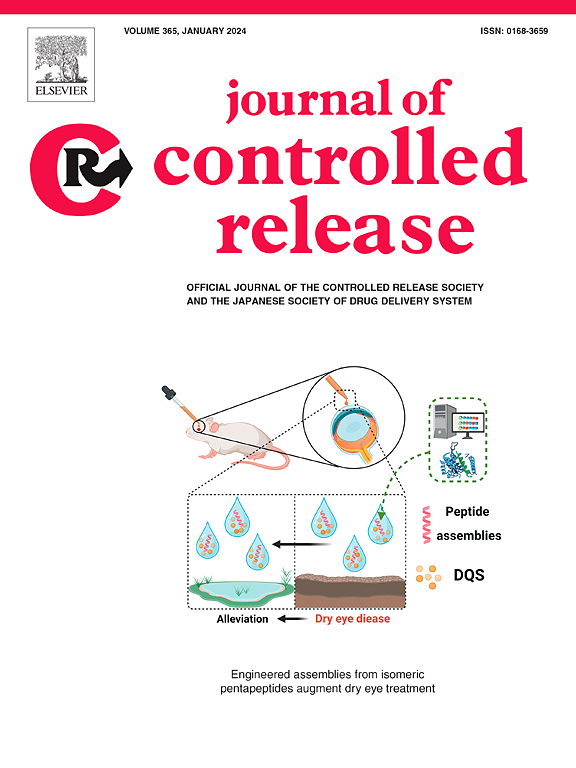Multivalent assembly of nucleolin-targeted F3 peptide potentiates TRAIL's tumor penetration and antitumor effects
IF 10.5
1区 医学
Q1 CHEMISTRY, MULTIDISCIPLINARY
引用次数: 0
Abstract
Tumor-targeting drug delivery holds great promise for cancer treatment but faces significant challenges in penetrating solid tumors to achieve optimal therapeutic efficacy. By harnessing the natural tissue-penetration effect conferred by the CendR motif, we identified that the nucleolin (NCL)-targeted peptide F3 possesses tumor-penetrating capabilities. Co-administration of F3 with doxorubicin and the apoptosis-inducing protein TRAIL enhanced effective tumor penetration and improved antitumor activity. Taking advantage of TRAIL's natural self-trimerization, we developed a novel fusion protein, F3-TRAIL. This design enabled the trivalent assembly of F3 when fused with TRAIL, significantly enhancing its binding to NCL-positive tumor endothelial and parenchymal cells, resulting in deeper tumor penetration and superior antitumor effects compared to TRAIL alone. Mechanistic studies revealed that the multivalent F3-enhanced engagement with tumor cells potentiated TRAIL to trigger death receptor-dependent apoptosis signaling, even in TRAIL-resistant tumor cells. Building on this success, we constructed F3-HexaTR using the SpyCatcher/SpyTag superglue ligation system to generate a hexameric TRAIL, further amplifying cytotoxicity and antitumor efficacy. Combined analysis of data from TCGA and GTEx revealed significantly elevated NCL expression across 18 solid tumor types, underscoring the clinical potential of F3-directed targeted therapy. These findings highlight that F3-mediated NCL targeting is an effective strategy to overcome tumor penetration barriers, particularly for protein drug delivery. This multivalent assembly approach represents an innovative avenue for enhancing the therapeutic efficacy of various agents in the treatment of solid tumors.

核蛋白靶向F3肽的多价组装增强了TRAIL的肿瘤渗透和抗肿瘤作用
肿瘤靶向药物递送在癌症治疗中具有很大的前景,但在穿透实体肿瘤以达到最佳治疗效果方面面临重大挑战。通过利用CendR基序赋予的自然组织穿透效应,我们发现核仁蛋白(NCL)靶向肽F3具有肿瘤穿透能力。F3与阿霉素和凋亡诱导蛋白TRAIL共同给药,增强了有效的肿瘤穿透能力,提高了抗肿瘤活性。利用TRAIL的自然自三聚化,我们开发了一种新的融合蛋白F3-TRAIL。该设计使F3与TRAIL融合时能够进行三价组装,显著增强其与ncl阳性肿瘤内皮细胞和实质细胞的结合,与TRAIL单独相比,具有更深的肿瘤穿透和更好的抗肿瘤作用。机制研究表明,多价f3增强与肿瘤细胞的结合可增强TRAIL,从而触发死亡受体依赖的凋亡信号,甚至在TRAIL抗性肿瘤细胞中也是如此。在此基础上,我们利用SpyCatcher/SpyTag超粘结扎系统构建了F3-HexaTR,生成了六聚TRAIL,进一步增强了细胞毒性和抗肿瘤功效。TCGA和GTEx数据的联合分析显示,在18种实体瘤类型中,NCL表达显著升高,强调了f3靶向治疗的临床潜力。这些发现强调f3介导的NCL靶向是克服肿瘤渗透障碍的有效策略,特别是对于蛋白质药物递送。这种多价组装方法代表了提高各种药物治疗实体肿瘤疗效的创新途径。
本文章由计算机程序翻译,如有差异,请以英文原文为准。
求助全文
约1分钟内获得全文
求助全文
来源期刊

Journal of Controlled Release
医学-化学综合
CiteScore
18.50
自引率
5.60%
发文量
700
审稿时长
39 days
期刊介绍:
The Journal of Controlled Release (JCR) proudly serves as the Official Journal of the Controlled Release Society and the Japan Society of Drug Delivery System.
Dedicated to the broad field of delivery science and technology, JCR publishes high-quality research articles covering drug delivery systems and all facets of formulations. This includes the physicochemical and biological properties of drugs, design and characterization of dosage forms, release mechanisms, in vivo testing, and formulation research and development across pharmaceutical, diagnostic, agricultural, environmental, cosmetic, and food industries.
Priority is given to manuscripts that contribute to the fundamental understanding of principles or demonstrate the advantages of novel technologies in terms of safety and efficacy over current clinical standards. JCR strives to be a leading platform for advancements in delivery science and technology.
 求助内容:
求助内容: 应助结果提醒方式:
应助结果提醒方式:


